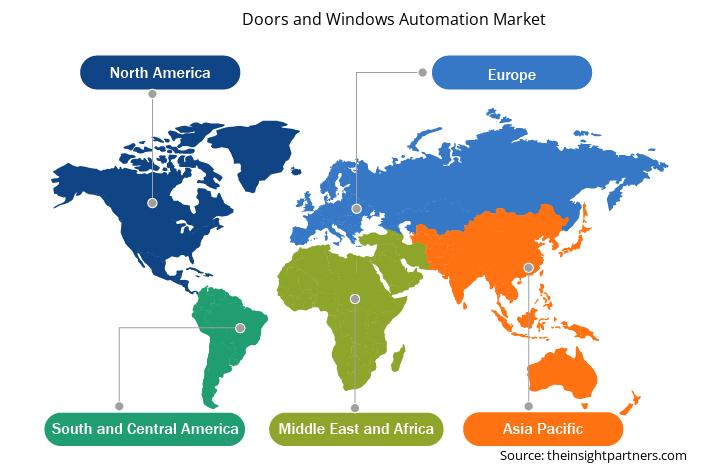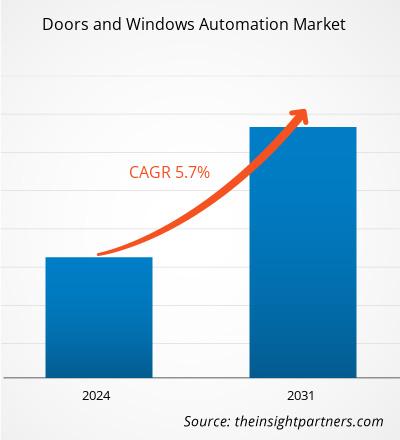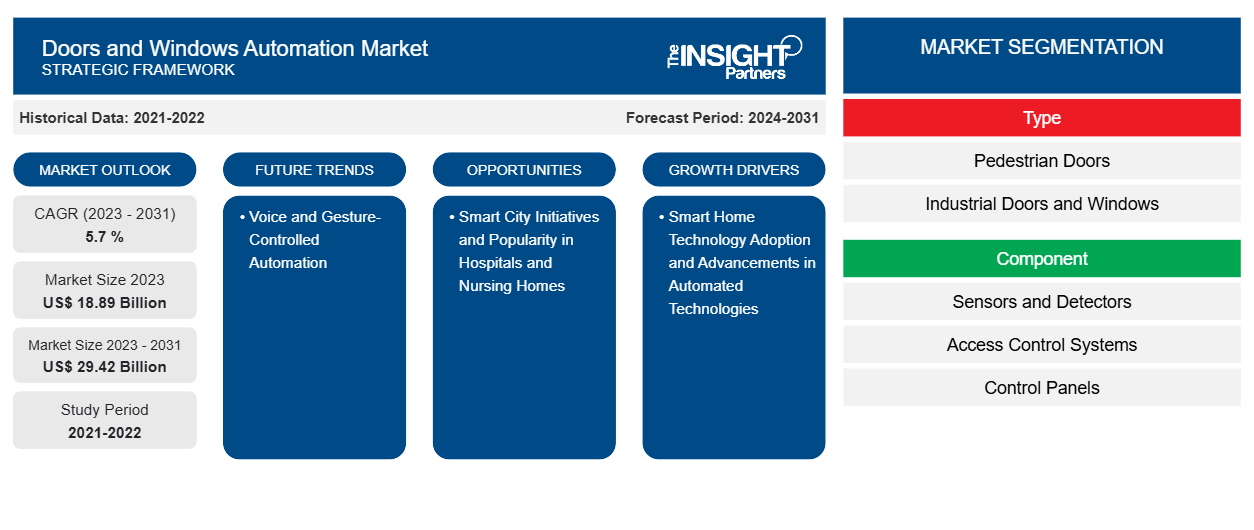ドアと窓の自動化市場規模は、2023 年の 188.9 億米ドルから 2031 年には 294.2 億米ドルに達すると予想されています。市場は 2023 年から 2031 年にかけて 5.7% の CAGR を記録すると予測されています。音声とジェスチャー制御の自動化は、今後数年間でドアと窓の自動化市場に新たなトレンドをもたらす可能性があります。
ドアと窓の自動化市場分析
スマートホーム技術の採用や自動化技術の進歩などの要因が、ドアと窓の自動化市場を牽引しています。市場は、スマートシティイニシアチブの増加と病院や介護施設での自動化システムの人気の高まりにより、予測期間中に成長すると予想されています。ドアと窓の自動化ソリューションの需要は、住宅と商業ビルの両方で利便性、安全性、エネルギー効率に対する需要の高まりなど、いくつかの重要な要因によって推進されています。スマートホームシステム、音声およびジェスチャー制御、モーションセンサーの統合などの技術の進歩により、ユーザーエクスペリエンスが向上し、シームレスな自動化が可能になります。持続可能性への注目の高まりも市場の成長に貢献しており、自動化されたドアと窓は換気を最適化し、エネルギー消費を削減してコスト削減につながります。さらに、特に医療および商業環境における衛生意識の高まりにより、タッチレス自動化システムの採用が加速しています。これらの要因は、都市化とスマートで接続された住宅への好みの高まりとともに、市場の拡大を促進しています。
ドアと窓の自動化市場の概要
ドアと窓の自動化とは、ドアと窓を自動的に操作し、利便性、セキュリティ、エネルギー効率、アクセシビリティを向上させる高度なテクノロジーの統合を指します。この自動化は、特定の条件またはユーザーコマンドに基づいてドアと窓を開閉できるセンサー、モーター、制御システムによって実現できます。一般的な機能には、タッチレス、音声起動、ジェスチャー制御の操作、および Amazon Alexa や Google Assistant などのプラットフォームを介してシームレスに制御するためのホームオートメーションシステムとのスマートな統合があります。これらの自動化システムは、住宅と商業ビルの両方でますます使用されており、安全性の向上、換気の最適化によるエネルギー節約、表面との物理的接触の削減による衛生の改善などの利点があります。
要件に合わせてレポートをカスタマイズする
このレポートの一部、国レベルの分析、Excelデータパックなど、あらゆるレポートを無料でカスタマイズできます。また、スタートアップや大学向けのお得なオファーや割引もご利用いただけます。
-
このレポートの主要な市場動向を入手してください。この無料サンプルには、市場動向から見積もりや予測に至るまでのデータ分析が含まれます。
ドアと窓の自動化市場の推進要因と機会
スマートホーム技術の導入
スマートホームには、住宅所有者がより高い利便性、快適性、エネルギー効率、セキュリティを求めているため、ドアと窓の自動化システムが組み込まれています。スマートホームテクノロジーの幅広いトレンドの一環として、接続されたデバイスの可用性が高まるとともに、消費者はますます自動化システムを自宅に取り入れ、日常生活の体験を向上させ、エネルギー消費を削減しています。Marvin、Somfy、WindowMaster、View Glassなどの企業は、自動化されたドアと窓をスマートホームに接続する高度なソリューションを提供しています。たとえば、2023年9月、室内窓カバーと屋外ソーラープロテクション用のモーターの世界有数のメーカーであるSomfyは、Apple Homeとの統合と認定を発表しました。この認定により、室内窓アプリケーションで使用されるSomfyのサポート対象Zigbeeモーターと、Apple Homeを備えたTaHomaスイッチとのシームレスな互換性が実現します。世界的に採用されている安全なIoTソリューションであるZigbee 3.0テクノロジーは、スマートホームデバイスを統合ネットワークに接続することで相互運用性を促進し、製品をスムーズに機能させます。この新しい統合により、iPhone、iPad、Apple Watch、HomePod、Mac などのデバイス上の Apple Home アプリや Siri を通じて、Zigbee モーターを使用して Somfy 駆動の電動窓カバーを簡単かつ安全に制御できるようになります。このように、スマート ホーム テクノロジーの採用は、ドアと窓の自動化市場を牽引します。
スマートシティの取り組み
都市は技術的に進歩し、接続性が高まるにつれて、建物の運用を最適化し、セキュリティを強化し、エネルギー効率を改善できる自動化されたインフラストラクチャの需要が高まっています。国連開発計画によると、世界の人口の60%以上が都市に住んでおり、そのうち70%以上が労働人口です。また、世界の経済価値の80%が都市で生み出されています。さまざまな国の政府は、インターネットを使用して情報を共有し、運用効率を改善し、スマートシティに住む市民に高品質のサービスを提供することに重点を置いたスマートシティに向けた取り組みを行っています。たとえば、都市開発省によると、インドの100都市で合計8,033件のプロジェクト(スマートシティミッション)があり、そのうち7,038件(88%)がすでに完了し、995件(12%)が進行中のプロジェクトです。同様に、中国政府は2023年に500以上のスマートシティを建設する計画を発表しました。 2023年7月、政府は広州スマートシティプロジェクトフェーズ1の開発に2億米ドル相当のプロジェクトを資金提供しました。スマートシティの取り組みには、ドアと窓の自動化システムを含むさまざまなスマートテクノロジーの採用が含まれており、運用のエネルギー効率と持続可能性を高め、炭素排出量を最小限に抑えます。また、ドバイでは、世界トップクラスのスマートシティになるという市のビジョンの一環として、いくつかの商業ビルに自動ドアと窓が組み込まれており、持続可能性と利便性のためのスマートテクノロジーの統合をサポートしています。さらに、ドバイはスマートシティ開発をリードし続けており、ドバイシリコンオアシスなどのプロジェクトでは、商業ビルと住宅ビルのエネルギー効率を最適化するために自動ドアと窓が組み込まれています。これらのシステムは、気象条件に基づいて自動的に調整するように設計されており、エネルギーの節約と炭素排出量の削減という市の目標に貢献しています。したがって、スマートシティプロジェクトの取り組みの増加により、予測期間中に市場の成長のためのさまざまな機会が生まれることが予想されます。
ドアと窓の自動化市場レポートのセグメンテーション分析
ドアと窓の自動化市場分析の導出に貢献した主要なセグメントは、タイプ、コンポーネント、制御システム、および業界垂直です。
- タイプに基づいて、ドアと窓の自動化市場は、窓、産業用ドア、歩行者用ドアに分類されます。歩行者用ドアセグメントは、2023年に市場を支配しました。
- コンポーネント別に見ると、ドアと窓の自動化市場は、アクセス制御システム、コントロールパネル、センサーと検出器、モーターとアクチュエーターなどに分類されます。センサーと検出器セグメントは、2023年に市場で最大のシェアを占めました。
- 制御システム別に見ると、ドアと窓の自動化市場は、全自動、半自動、パワーアシストに分類されます。2023年には、全自動セグメントが市場を支配しました。
- 業界別では、ドアと窓の自動化市場は住宅、商業、産業に分類されます。2023年には、商業部門がドアと窓の自動化市場で最大のシェアを占めました。
ドアと窓の自動化市場シェアの地域別分析
ドアと窓の自動化市場は、北米、ヨーロッパ、アジア太平洋 (APAC)、中東およびアフリカ (MEA)、南米および中米の 5 つの主要地域に分割されています。2023 年には北米が市場を支配し、ヨーロッパと APAC がそれに続きました。
北米のドアと窓の自動化市場は、米国、カナダ、メキシコに分かれています。北米の主要国では、スマート ホームやスマート シティ プログラムの大幅な増加が見られます。この地域のさまざまな国の政府はスマート シティの導入を奨励しており、住宅や商業施設の建設活動が促進され、自動化されたドアと窓の需要が高まると予想されています。ドアと窓のシステムに自動化技術を統合すると、ドアと窓を最適な期間ロックまたはロック解除したままにできるため、エネルギーを節約できます。
ドアと窓の自動化市場の地域別洞察
予測期間を通じてドアと窓の自動化市場に影響を与える地域的な傾向と要因は、Insight Partners のアナリストによって徹底的に説明されています。このセクションでは、北米、ヨーロッパ、アジア太平洋、中東、アフリカ、南米、中米にわたるドアと窓の自動化市場のセグメントと地理についても説明します。

- ドアと窓の自動化市場の地域別データを入手
ドアと窓の自動化市場レポートの範囲
| レポート属性 | 詳細 |
|---|---|
| 2023年の市場規模 | 188.9億米ドル |
| 2031年までの市場規模 | 294.2億米ドル |
| 世界のCAGR(2023年~2031年) | 5.7 % |
| 履歴データ | 2021-2022 |
| 予測期間 | 2024-2031 |
| 対象セグメント |
タイプ別
|
| 対象地域と国 |
北米
|
| 市場リーダーと主要企業プロフィール |
|
ドアと窓の自動化市場のプレーヤーの密度:ビジネスダイナミクスへの影響を理解する
ドアと窓の自動化市場は、消費者の嗜好の変化、技術の進歩、製品の利点に対する認識の高まりなどの要因により、エンドユーザーの需要が高まり、急速に成長しています。需要が高まるにつれて、企業は提供品を拡大し、消費者のニーズを満たすために革新し、新たなトレンドを活用し、市場の成長をさらに促進しています。
市場プレーヤー密度とは、特定の市場または業界内で活動している企業または会社の分布を指します。これは、特定の市場スペースに、その市場規模または総市場価値に対してどれだけの競合相手 (市場プレーヤー) が存在するかを示します。
ドアと窓の自動化市場で事業を展開している主要企業は次のとおりです。
- ABB株式会社
- アリージョン社
- アッサ・アブロイAB
- カムSpA
- ハネウェルインターナショナル
- インステオン
免責事項:上記の企業は、特定の順序でランク付けされていません。

- ドアと窓の自動化市場のトップキープレーヤーの概要を入手
ドアと窓の自動化市場のニュースと最近の動向
ドアと窓の自動化市場は、主要な企業出版物、協会データ、データベースなどの一次調査と二次調査後の定性的および定量的データを収集することによって評価されます。ドアと窓の自動化市場における主要な開発のいくつかを以下に示します。
- Allegion plc は、子会社の 1 つを通じて SOSS Door Hardware (SOSS) を買収しました。高級ヒンジとドア ハードウェアの大手メーカーである SOSS は、主に北米の非住宅市場でソリューションを販売しています。SOSS ソリューションは、同社の Ives、Glynn-Johnson、Zero International のドア ハードウェアを補完し、より幅広いポートフォリオを指定して顧客に提供できるようにすることで、最終的にこのビジネスの中核部分を成長させます。
(出典:Allegion plc、プレスリリース、2024年10月)
- ABB は、今年のフランクフルトで開催される Light + Building 見本市で、ABB-Welcome ドア エントリー システムのポートフォリオのアップグレードを発表しました。ABB-Welcome と ABB-Welcome IP の次世代バージョンは、進化したデザイン、簡素化されたシステム アーキテクチャ、強化された接続性を備えて発売されました。ABB-Welcome は、幅広いモジュール設計を備えた、ドア通信用の多用途 2 線ソリューションを提供します。屋外および屋内ステーションのフル レンジで構成されています。ゲート、正面玄関、エントランス ドアなどの家のエントランス エリアは、携帯電話に簡単に接続でき、ドアでかかってきた電話にすばやく応答できます。さらに、アプリを介してリモートでアクセスを許可することもできます。
(出典:ABB、プレスリリース、2024年3月)
ドアと窓の自動化市場レポートの対象範囲と成果物
「ドアと窓の自動化市場の規模と予測(2021〜2031年)」では、以下の分野をカバーする市場の詳細な分析を提供します。
- 対象範囲に含まれるすべての主要市場セグメントについて、世界、地域、国レベルでのドアと窓の自動化市場の規模と予測
- ドアと窓の自動化市場の動向、および推進要因、制約、主要な機会などの市場動向
- 詳細なPESTおよびSWOT分析
- 主要な市場動向、世界および地域の枠組み、主要プレーヤー、規制、最近の市場動向を網羅したドアと窓の自動化市場分析
- 市場集中、ヒートマップ分析、主要プレーヤー、ドアと窓の自動化市場における最近の動向を網羅した業界の状況と競争分析
- 詳細な企業プロフィール
- 過去2年間の分析、基準年、CAGRによる予測(7年間)
- PEST分析とSWOT分析
- 市場規模価値/数量 - 世界、地域、国
- 業界と競争環境
- Excel データセット
最新レポート
関連レポート
お客様の声
購入理由
- 情報に基づいた意思決定
- 市場動向の理解
- 競合分析
- 顧客インサイト
- 市場予測
- リスク軽減
- 戦略計画
- 投資の正当性
- 新興市場の特定
- マーケティング戦略の強化
- 業務効率の向上
- 規制動向への対応























 無料サンプルを入手 - ドアと窓の自動化市場
無料サンプルを入手 - ドアと窓の自動化市場